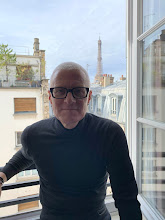Earlier this week I was lucky enough to be invited to a private screening of Grant Gee's latest film, Patience (After Sebald). The film is a reflective essay on the influence of the writings of the novelist and scholar W. G. Sebald but more specifically it is an attempt to follow in Sebald's footsteps, both literally and metaphorically. The film takes as its direct inspiration Sebald's The Rings of Saturn and recreates the journey taken by Sebald within it as he traverses his adopted home county of Suffolk. The film also structures itself along what might be called 'Sebaldian' lines, mimicking the author's famously digressive style of narration. I have to confess to not having read, as yet, any Sebald, although having now seen this wonderful film I intend to rectify this as soon as possible; however, the film 'spoke' to me very powerfully. The places - Southwold, Dunwich, Orford - explored by both Sebald in The Rings of Saturn and Gee in Patience are very familiar to me and I found that the aesthetic beauty of the film, partly shot on 16mm, captured something of the schizophrenia of the Suffolk coast that can function as both summer holiday destination and an impossibly bleak and desolate location. The Rings of Saturn opens by expressing precisely this dual state with Sebald combining the 'carefree' with a growing sense of melancholy: 'In August 1992 when the dog days were drawing to an end, I set off to walk the county of Suffolk, in the hope of dispelling the emptiness that takes hold of me whenever I have completed a long stint of work. And in fact my hope was realised, up to a point; for I have seldom felt so carefree as I did then, walking for hours in the day through the thinly populated countryside, which stretches inland from the coast' (2002).
The passage captures, for me, something of Freud's celebrated essay 'On Transience' (1916), in which the psychoanalyst explores mourning and memory. In this short piece, Freud describes an episode in which a poet and a somewhat reserved friend, thought to be Rainer Maria Rilke and Lou Andreas-Salomé respectively, are unable to enjoy a scene of beauty because ‘it was fated to extinction’. Freud, in his analysis of his friends’ reactions, surmises that ‘[t]he idea that all this beauty was transient was giving these two sensitive minds a foretaste of mourning over its decease’. In a similar fashion Sebald is overcome by a melancholy that bleeds into his initial pleasure: 'in retrospect I became preoccupied not only with the unaccustomed sense of freedom but also with the paralysing horror that had come over me at various times when confronted with the traces of destruction, reaching far back into the past, that were evident even in that remote place'. There is a moment in the film that recounts a scene from The Rings of Saturn in which Sebald loses himself in the scrubland heath that characterises much of the Suffolk countryside. Sebald becomes disoriented and finds himself walking in circles, an irrational sense of terror taking hold as he struggles to find his way of out the suddenly unfamiliar landscape. I recall just such a moment myself, experienced when walking similar terrain - 'Sailor's Path' between Aldeburgh and Snape - as a child. It is one of those cinematic encounters that prompts a certain kind of time travel, transporting one back with breathtaking immediacy to a moment from one's past...
Gee's film weaves together interviews with individuals who knew Sebald whether as colleagues, fellow writers or publishers and constructs a compelling portrait of a fascinating writer. We learn very little about Sebald the man but a great deal about Sebald the author. It is through the Sebaldian text, whether read - beautifully by Jonathan Pryce - or glimpsed on screen that this author is made present to the spectator.
The visibility of the text in the film is reminiscent of Greenaway's experiments in Prospero's Books (1991) and The Pillow Book (1996) but here the written word is far less visually heavy than in Greenaway's almost overly rich and lushly coloured works. The starkness of the black and white film stock and the texture of the grain is compelling and beautiful. Gee spoke at the screening of the importance of place for him in his work and this is evident in the care with which he has sought to capture the desolate beauty of the Suffolk landscape. There is a detachment and an alienation at the heart of these beautiful images that reflects the strange confluence of land, sea and sky that for me at any rate typify this particular coastline.
Whether a Sebaldian or not this is a film that deserves recognition for not only is it a powerful aesthetic statement in its own right, it is also an enchanting portrait of a text, its author and a place, an ultimately uncanny place, that Sebald called home...
Omnishambles at the BBC
2 years ago




No comments:
Post a Comment